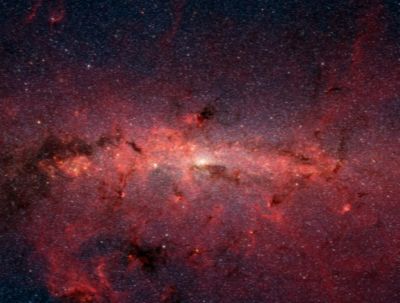To see heat, you’d better be cold. In space, at least, because when you’re looking in infrared wavelengths, the heat of your instrumentation can overwhelm the image you’re trying to get. Infrared light is hugely useful, especially when it lets us see through clouds of dust to what lies beyond. Take a look at the image below, which penetrates the dust to show stars in the center of the Milky Way. I ran into it thanks to a post on QUASAR9 and have been musing about spacecraft cooling ever since.
Image: A mosaic of many smaller snapshots, the detailed, false-color image shows older, cool stars in bluish hues. Reddish glowing dust clouds are associated with young, hot stars in stellar nurseries. The galactic center lies some 26,000 light-years away, toward the constellation Sagittarius. Credit: Susan Stolovy (SSC/Caltech) et al., JPL-Caltech, NASA.
The Spitzer Space Telescope, which caught this image with its infrared cameras, has to be cooled to near absolute zero (-459 degrees Fahrenheit or -273 degrees Celsius) to avoid interference from its own heat. And it must also be shielded from the heat of both the Sun and the Earth, the first of which is accomplished through a solar shield, the second by an orbit far enough from Earth to maintain the necessary temperatures with less expenditure of onboard coolant.
The James Webb Space Telescope and supporting instruments will need a sunshield of their own to provide the necessary cooling. And on that score, the testing of the shield — five layers of kapton with aluminum and silicon coatings to reflect solar heat into space — has been successfully completed. JWST won’t launch until 2014, but shield coatings and the cryocooler for the instrument’s mid-IR detectors now seem proven.
But we’re not just talking infrared. Efficient cooling is also critical for the European Space Agency’s Planck mission, scheduled for a 2008 launch. Planck works at microwave wavelengths, the band of radiation between the infrared and radio region. And in its studies of the cosmic microwave background (CMB), Planck will use a cooling system for which one scientist can find a homely analogy. Tom Bradshaw (CCLRC) puts it this way:
“Planck presents real technological challenges with regard to the temperatures that the instruments need to operate at. The spacecraft has a layered cooling system, akin to a Russian doll, which keeps the instruments cooled so that their own heat does not interfere with the science measurements.”
Challenging is right. Planck’s cryogenic cooling system brings the instruments down to a range from -253 degrees Celsius to only a tenth of a degree above absolute zero. All this by way of measuring temperature variations across the CMB with extraordinary precision. In fact, the instruments aboard Planck will be sensitive to temperature variations of a few millionths of a degree as they map the sky in nine different wavelengths.
What Planck will measure isn’t exactly warm. In fact, the operative temperature of the CMB radiation is around 2.7 degrees Kelvin (-270 degrees Celsius). Current measurements of the CMB go to three decimal figures (thank you Cosmic Background Explorer and Wilkinson Microwave Anisotropy Probe!), but Planck will go a lot further at measuring the temperature differences that can show us how galaxies were born.
The upshot: We’ll get a look at the universe of about 300,000 years after the Big Bang, allowing us to learn more about dark matter and dark energy, not to mention the role of inflation in the early cosmos. Measuring the temperature of the cosmic microwave background may tell us much about the universe’s future expansion. The news from Alcatel Alenia Space (Cannes, France) is that the instruments in question are now being integrated into the satellite. Next up for Planck is a move to Belgium for performance tests at extreme temperatures.



Sunday, June 21, 2009
Deceased–Frank J. Low
Frank J. Low
November 23rd, 1933 to June 11th, 2009
“Frank J. Low, Who Helped Drive Field of Infrared Astronomy, Dies at 75”
by Dennis Overbye
June 21st, 2009
The New York Times
Frank J. Low, who helped astronomers extend their vision beyond visible light into a vast realm of previously invisible colors, revolutionizing the study of the birth of planets, stars and galaxies, died on June 11 in Tucson. He was 75.
His death, after a long illness, was announced by the University of Arizona, where he had been a professor since 1965.
Starting as a young physicist at Texas Instruments in 1961, Dr. Low spent his career developing devices to detect and measure infrared, or “heat,” radiation from stars and getting them deployed in telescopes, airplanes and satellites.
Using Dr. Low’s devices and their successors, astronomers have been able to peer through dust clouds to find the birthplaces of stars; discover galaxies and quasars invisible to ordinary telescopes; discern rings of dust and, recently, even planets around other stars; and study what is believed to be residual heat left over from the Big Bang.
NASA’s next big effort, the James Webb Space Telescope, destined for a 2014 launching, is an infrared space telescope built in a design Dr. Low created.
Full article here:
http://philosophyofscienceportal.blogspot.com/2009/06/deceased-frank-j-low.html